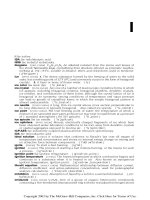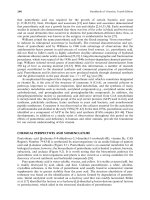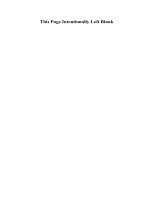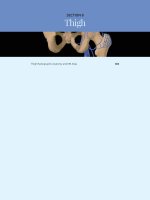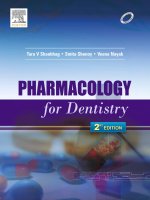Ebook Handbook of PLAB (2nd edition): Part 1
Bạn đang xem bản rút gọn của tài liệu. Xem và tải ngay bản đầy đủ của tài liệu tại đây (2.01 MB, 420 trang )
Handbook of
PLAB
Handbook of
PLAB
Second Edition
Kunal Goyal MBBS MRCP
Specialist Registrar
West Midlands Deanery, UK
Seema Mittal MBBS
Senior House Officer
Manchester
JAYPEE BROTHERS
MEDICAL PUBLISHERS (P) LTD
New Delhi
Published by
Jitendar P Vij
Jaypee Brothers Medical Publishers (P) Ltd
EMCA House, 23/23B Ansari Road, Daryaganj
New Delhi 110 002, India
Phones: 23272143, 23272703, 23282021, 23245672, 23245683
Fax: 011-23276490 e-mail:
Visit our website:
Branches
• 202 Batavia Chambers, 8 Kumara Kruppa Road, Kumara Park East,
Bangalore 560 001, Phones: 2285971, 2382956 Tele Fax: 2281761
e-mail:
• 282 IIIrd Floor, Khaleel Shirazi Estate, Fountain Plaza
Pantheon Road, Chennai 600 008, Phone: 28262665 Fax: 28262331
e-mail:
• 4-2-1067/1-3, Ist Floor, Balaji Building, Ramkote
Cross Road, Hyderabad 500 095, Phones: 55610020, 24758498
Fax: 24758499 e-mail:
• 1A Indian Mirror Street, Wellington Square
Kolkata 700 013, Phone: 22451926 Fax: 22456075
e-mail:
• 106 Amit Industrial Estate, 61 Dr SS Rao Road, Near MGM Hospital
Parel, Mumbai 400 012 , Phones: 24124863, 24104532 Fax: 24160828
e-mail:
Handbook of PLAB
© 2003, Kunal Goyal, Seema Mittal
All rights reserved. No part of this publication should be reproduced, stored in a retrieval
system, or transmitted in any form or by any means: electronic, mechanical, photocopying, recording, or otherwise, without the prior written permission of the authors and the
publisher.
This book has been published in good faith that the material provided by authors is
original. Every effort is made to ensure accuracy of material, but the publisher, printer
and authors will not be held responsible for any inadvertent error(s). In case of any
dispute, all legal matters to be settled under Delhi jurisdiction only.
First Edition: 2001
Second Edition: 2003
ISBN 81-8061-190-6
Typeset at JPBMP typesetting unit
Printed at Gopsons Papers Ltd., Noida
Preface to the First Edition
Handbook of PLAB is an effort to provide its readers an understanding of the new pattern of this examination from the year
2000. It is the first book of its kind wherein the author has tried
his best to make it easily readable and easy to follow. It incorporates about 3500 extended matching questions (EMQs) covering all the major topics. More stress has been laid on the topics which are rendered important from the point of view of the
PLAB examination. First timers (beginner aspirants) as well as
those who have been preparing already will find the Handbook equally useful. The author is quite hopeful that the latter
will find it of immense use for revision and refresh whatever
they have read before.
The author got the idea of writing the book when he along
with his friends and colleagues was preparing for the PLAB
examination. This new pattern examination was totally new so
the author and his friends had to face a new unknown challenge hence they felt the need of such a book all the more. This
book has been written with the first hand experience gained by
the author himself.
Learning can be self or from the experience of others. The
author was not lucky enough to learn from the experience of
others so he had to venture himself in the blind alleys. However, the experience had been quite useful and hence this book.
The author is quite hopeful that it will meet the needs of the
students in their preparation of the PLAB. Candid comments
from the readers are most welcome.
Kunal Goyal
Acknowledgements
We owe my heartfelt gratitude to:
My brother, Amit, whose unconditional support and inspiration has helped me to reach where I an today.
Our parents who have stood by me at all times.
All the well wishers for all their support and assistance.
Mr JP Vij, Chairman and Managing Director of M/s Jaypee
Brothers Medical Publishers (P) Ltd., and his team of dedicated
staff for their untiring efforts.
Preface to the Second Edition
The huge success of the first edition filled me with enthusiasm,
to work hard to update the book. When I first wrote the book,
being the first one in the field, just after first exam based on
new pattern, I do realize it had questions, which were difficult
and not really suitable for PLAB.
Over time, we have learnt more about GMC questioning
style and topics of interest and importance. We have tried our
best to add on the relevant questions and change the previous
ones to make this book an essential read for all PLAB aspirants.
First time (beginner aspirants) as well as those who have been
prepairing already will find the handbook equally useful. We
are quite hopeful that the latter will find it of immense use for
revision and refresh whatever they have read before.
I do hope all of you enjoy the book, as much as we did revising it. We are as always open to candid comments from our
readers.
Kunal Goyal
Seema Mittal
Contents
1. Cardiovascular System ......................................................... 1
2. Respiratory Diseases ........................................................... 55
3. Neurology .............................................................................. 96
4. Hematology ......................................................................... 168
5. Endocrinology .................................................................... 191
6. Gastroenterology ............................................................... 212
7. Rheumatology .................................................................... 290
8. Infectious Diseases ............................................................ 315
9. Oncology ............................................................................. 353
10. Emergencies ........................................................................ 366
11. Ethics .................................................................................... 386
12. Pharmacology ..................................................................... 392
13. Dermatology ....................................................................... 412
14. Surgery ................................................................................. 440
15. Radiology ............................................................................ 531
16. Biochemistry ....................................................................... 534
17. Pediatrics ............................................................................. 544
18. Orthopedics ......................................................................... 600
19. Psychiatry ............................................................................ 635
20. Ear, Nose and Throat ......................................................... 662
21. Ophthalmology .................................................................. 682
22. Obstetrics ............................................................................. 698
23. Gynecology ......................................................................... 736
24. Renal Diseases ................................................................... 779
25. Miscellaneous ..................................................................... 816
Answers ................................................................................. 829
READER SUGGESTIONS SHEET
Please help us to improve the quality of our publications by completing and returning
this sheet to us.
Title/Author: Handbook of PLAB 2/E— by Kunal Goyal and Seema MIttal
Your name and address:
E-mail address,
Phone and Fax:
How did you hear about this book? [please tick appropriate box (es)]
Direct mail from publisher
Conference
Bookshop
Book review
Lecturer recommendation
Friends
Other (please specify)
Website
Type of purchase:
Direct purchaseBookshop
Friends
Do you have any brief comments on the book?
Please return this sheet to the name and address given below.
JAYPEE BROTHERS
MEDICAL PUBLISHERS (P) LTD
EMCA House, 23/23B Ansari Road, Daryaganj
New Delhi 110 002, India
one
Cardiovascular System
THEME: 1
INTERPRETATION OF PULSE RATE
Options
a.
b.
c.
d.
e.
Regular fast palpitations.
Regular slow palpitations.
Irregular fast palpitations.
Dropped beats
Regular and pounding.
For each of the situations/conditions given below, choose
the one most appropriate/discriminatory option from above.
The options may be used once, more than once, or not at all.
Questions
1.
2.
3.
4.
5.
6.
Pulsus bigeminus.
Anxiety.
Atrial fibrillation.
Atrial ectopics.
Atrial flutter.
Patient on beta blockers.
THEME: 2
DIAGNOSIS OF APEX BEAT
Options
a.
b.
c.
d.
e.
f.
Undisplaced, tapping apex.
Displaced, forceful apex.
Undisplaced, heaving apex.
Displaced, hyperdynamic apex.
Dyskinetic.
Double impluse.
2
Handbook of PLAB
For each of the situations/conditions given below, choose
the one most appropriate/discriminatory option from above.
The options may be used once, more than once, or not at all.
Questions
7.
8.
9.
10.
11.
12.
Aortic stenosis.
Mitral stenosis
Anterior wall myocardial infarction (MI)
Aortic regurgitation.
Cardiomyopathy.
Mitral regurgitation.
THEME: 3
TYPES OF PERIPHERAL PULSES
Options
a.
b.
c.
d.
e.
f.
g.
Aortic stenosis.
Severe aortic regurgitation.
Dilated cardiomyopathy.
Toxic myocarditis.
Pericarditis.
Atrio-ventricular block.
Liver failure.
For each of the situations/conditions given below, choose
the one most appropriate/discriminatory option from above.
The options may be used once, more than once, or not at all.
Questions
13.
14.
15.
16.
17.
18.
19.
20.
21.
Pulsus paradoxus.
Anacrotic pulse.
Pulsus parvus et tardus.
Plateau pulse.
Pulsus alternans.
Bounding pulse.
Dicrotic pulse.
Pulsus bisferiens.
Pulsus bigeminus.
Cardiovascular System
3
THEME: 4
INTERPRETATION OF JVP
Options
a.
b.
c.
d.
e.
f.
g.
Raised JVP with normal waveform.
Raised JVP with absent pulsation.
Large ‘a’ wave.
Cannon wave.
Systolic ‘cv’ waves.
Deep ‘y’ descent.
Absent a wave
For each of the situations/conditions given below, choose
the one most appropriate/discriminatory option from above.
The options may be used once, more than once, or not at all.
Questions
22.
23.
24.
25.
26.
27.
28.
Tricuspid stenosis.
Tricuspid regurgitation.
Constrictive pericarditis.
SVC obstruction.
Pulmonary hypertension.
Atrial flutter.
Atrial fibrillation.
THEME: 5
ECG – ABNORMALITIES
Options
a.
b.
c.
d.
e.
f.
g.
h.
i.
j
ST depression and inverted T–wave in V5–6.
Small T waves, prominent ‘V’ waves, ventricular bigemini.
Tall tended T waves, ST segment depression.
Short QT interval.
Prolonged QT interval.
ST elevation.
Saddle shaped ‘ST’ in all leads except aVR.
‘V’ wave.
Delta wave.
‘J’ wave.
4
Handbook of PLAB
For each of the situations/conditions given below choose
the one most appropriate/discriminatory option from above.
The options may be used once, more than once, or not at all.
Questions
29.
30.
31.
32.
33.
34.
35.
36.
WPW syndrome.
Hypokalemia.
Hypothermia.
Hyperkalemia.
Hypercalcemia.
Digoxin toxicity.
Myocardial infarction.
Acute pericarditis.
THEME: 6
ECG INTERPRETATION
Options
a. Hypothermia
b. Pyrexia
c. RA hypertrophy
d. LA hypertrophy
e. RVH
f. LVH
g. Conduct defect
h. MI
i. IHD
j. Pulmonary hypertension
k. Myocarditis
l. Rheumatic heart disease
m. Potassium excess
n. Hypothyroidism
For each of the situations/conditions given below, choose
the one most appropriate/discriminatory option from above.
The option may be used once, more than once, or not at all.
Cardiovascular System
5
Questions
37. A teenage boy with dyspnoea and chest pain is brought
into A&E. He has a history of rheumatic fever. An ECG
demonstrates LAH and LVH. It also demonstrates Q
waves and raised ST segments.
38. An elderly woman is found unconscious at home. An ECG
demonstrates sinus bradycardia, J waves, ST depression
and flattened T waves.
39. A patients ECG shows a biphasic P wave.
40. A patients ECG shows T waves inversion and ST depression.
41. A 35-year-old woman complains of tiredness and malaise. Her T waves are widespread and deep.
THEME: 7
INTERPRETATION OF ABNORMAL ECG
Options
a.
b.
c.
d.
e.
f.
g.
h.
i.
j.
k.
l.
Hypokalemia
Hyperkalemia
Hypocalcemia
Hypercalcemia
Myocardial ischaemia
Inferior MI
Acute pulmonary embolism
Acute pericarditis
Atrial fibrillation
Myxoedema
Digitalis intoxication
Inferolateral MI
For each of the situations/conditions given below, choose
the one most appropriate/discriminatory option from above.
The option may be used once, more than once, or not at all.
Questions
42. A 60-year-old woman taking frusemide is noted to have
U waves in V3 and V4.
6
Handbook of PLAB
43. A 50-year-old man presents with fever and chest pain.
He has a history of angina. His ECG reveals concave elevations of the ST segments in leads II, V5 and V6.
44. A 55-year-old presents with chest pain and dyspnoea. His
ECG reveals Q waves in leads III and aVF and inverted T
waves in leads V1-3.
45. A 55-year-old woman who has undergone thyroidectomy
is noted to have an ECG with a QT interval of 0.5 sec.
46. A 60-year-old woman presents with hoarseness. She is a
smoker and is on prozac. Her pulse rate is 44/min and
the ECG is noted for sinus bradycardia and reduced amplitude of P, QRS and T waves in all leads.
THEME: 8
INTERPRETATION OF ECG
Options
a.
b.
c.
d.
e.
f.
g.
h.
i.
j.
k.
RBBB
Second degree block
Hyperkalemia
PTE
Sinus arrhythmia
Anterior MI
LBBB
WPW syndrome
Complete heart block
1st degree block
2nd degree block (mobitz type 2)
For each of the situations/conditions given below, choose
the one most appropriate/discriminatory option from above.
The option may be used once, more than once, or not at all.
Questions
47. Progressive lengthening of PR interval with one nonconduncted beat.
48. Constant PR interval but one P wave is not followed by a
QRS complex.
Cardiovascular System
7
49. One P wave per QRS complex, constant PR interval and
progressive beat to beat change in the RR interval.
50. Dominant R in V1 and inverted T in the anterior chest
leads.
51. Peaked P waves, right axis deviation, inverted T waves
in leads V1 to V3 and tall R waves in V1.
52. Dominant R waves in V1, inverted T waves in leads V1-3
and deep S waves in V6.
THEME: 9
INTERPRETATION OF ECG ABNORMALITIES
Options
a.
b.
c.
d.
e.
f.
g.
h.
i.
j.
k.
l.
Pulmonary embolism
Angina
Hyperkalemia
Hypokalemia
Hypothyroidism
Hypothermia
Hypocalcemia
Hypercalcemia
Hypertension with LVH
Acute pericarditis
Severe pneumonia
Pericardial effusion
For each of the situations/conditions given below, choose
the one most appropriate/discriminatory option from above.
The option may be used once, more than once, or not at all.
Questions
53. J waves, bradycardia and first degree heart block.
54. Prolonged QT, all ST segments elevated and show characteristic saddle shape.
55. Shortened QT interval.
56. Tall QRS complexes with LVH pattern
57. Atrial fibrillation, self-resolving.
8
Handbook of PLAB
THEME: 10
DIAGNOSIS OF CHEST PAIN
Options
a. Anxiety
b. Massive pulmonary embolism
c. Pulmonary HTN
d. Pulmonary infarction
e. Pneumothorax
f. IHD
g. Dissecting aneurysm
h. Chylothorax
i. Oesophagitis
j. MI
k. Carcinoma
l. Asthma
m. Pneumonia
n. Dry pleurisy
For each of the situations/conditions given below, choose
the one most appropriate/discriminatory option from above.
The option may be used once, more than once, or not at all.
Questions
58. A 48-year-old man complains of chest pain. He describes
it as gripping and crushing and involving whole chest.
He says he has had to give up exercise because it aggravates the pain and makes both hands numb.
59. A middle-aged lady complains of chest pain, breathlessness and fainting. On examination there is a prominent a
wave in JVP, a right ventricular heave and a loud P2.
60. A 53-year-old man is brought to A&E with crushing chest
pain and pallor. He cannot breathe and his heart is racing. His sputum is blood stained; he has a pleural rub
and pyrexia.
61. A young man brought to hospital in a state of collapse.
He was at his desk saw the value of his stocks fall and felt
a constricting pain in the chest. A few moments later he
woke up in the ambulance.
Cardiovascular System
9
62. A 50-year-old lady complains of chest pain radiating
across the chest. She says her muscles are very tender.
Breathing aggravates the pain and coughing brings tears
to her eyes. She thinks she has had a heart attack.
THEME: 11
DIAGNOSIS OF CHEST COMPLAINTS
Options
a. Bronchogenic carcinoma
b. Cushing’s disease
c. Hyperparathyroidism
d. Diabetes mellitus
e. Steroid abuse
f. Coarctation of the aorta
g. Conn’s syndrome
h. Acromegaly
i. Alcoholism
j. PAN
k. Systemic sclerosis
l. Essential hypertension
m. Chronic pyelonephritis
n. Insulinoma
For each of the situations/conditions given below, choose
the one most appropriate/discriminatory option from above.
The option may be used once, more than once, or not at all.
Questions
63. A 38-year-old woman complains of feeling bloated and
recurrent chest infections. She says she bruises easily and
has missed periods. On examination you find her BP to
be high.
64. A 40-year-old man presents with sweating, headaches and
hypertension. He also complains of joint pain muscle
weakness and numbness in both hands. Over the past few
months he has become increasingly breathless and his
ankles have swollen up.
10
Handbook of PLAB
65. A 48-year-old woman presents with fever, malaise, weight
loss and joint pains. She has high blood pressure and large
feet. She complains of persistent chest pain. She has purpuric rash and skin nodules.
66. A middle-aged man presents with abdominal pain and
bone pain. He has hypertension and a recent history of
recurrent renal stones.
67. At a routine health check up you carry out a fundoscopy
on an apparently healthy man. You find he has an arteriolar narrowing and tortuosity and an increased light reflex.
THEME: 12
DIAGNOSIS OF HEART CONDITIONS
Options
a.
b.
c.
d.
e.
f.
g.
h.
i.
j.
k.
Anterolateral MI
LVF
AF
Acute pulmonary embolism
Acute pericarditis
Mitral stenosis
RVF
Hypokalemia
Hypocalcemia
Aortic regurgitation
Inferolateral MI
For each of the situations/conditions given below, choose
the one most appropriate/discriminatory option from above.
The option may be used once, more than once, or not at all.
Questions
68 A 60-year-old man presents with chest pain radiating
down his left arm. His 12 lead ECG shows Q waves in II ,
III and aVF with T wave changes in V5 and V6.
69. A 50-year-old woman presents with a fast heart rate with
an irregular rhythm. There are no P waves on the ECG.
Cardiovascular System 11
She states that she has lost weight recently and is nervous. She also suffers from palpitations.
70. On auscultation a patients is noted to have a rumbling
diastolic murmur at the apex. The murmur is accentuated during exercise.
71. A 60-year-old man on digitalis and diuretics presents with
a raised JVP, hepatomegaly, ankle and sacral oedema.
THEME: 13
DIAGNOSIS OF CHEST PAIN
Options
a. Pneumothorax.
b. Aortic dissection.
c. Lobar pneumonia.
d. Pulmonary embolism.
e. Postherpetic neuralgia.
f. Myocardial infarction.
g. Trauma.
h. Peptic ulcer.
i. Pericarditis.
j. Hypertrophic cardiomyopathy.
k. Esophageal reflux.
l. Cervical disc disease.
m. Costochondritis.
n. Breast disease.
o. Esophageal spasm.
For each of the situations/conditions given below choose
the one most appropriate/discriminatory option from above.
The options may be used once, more than once, or not at all.
Questions
72. A collapsed 34-year-old male patient is brought to the
emergency room. He was playing basketball, when he
complained of severe chest pain and collapsed. On examination is drowsy but arousable. Pulse 126/min regular and not palpable on the left radial/brachial artery. ECG
and chest X-ray normal.
12
Handbook of PLAB
73. A 48-year-old heavy smoker complains of severe chest
pain radiating to the left shoulder of 30 minutes duration. He has had previous episodes on walking up hill.
On examination he is sweating, has a pulse of 98/min,
BP 150/90 mm Hg and normal heart sounds. ECG is still
awaited.
74. A 21-year-old student became suddenly breathless and
had left sided chest pain during a cycling trip.
75. A well built young man has recurrent chest pain. On examination he has jerky pulse and a soft systolic murmur.
76. Localized, sharp pain exacerbated by coughing and respiration.
77. Pain following or accompanying eating and increased by
bending, hot drinks or lying supine.
78. Central chest pain radiating to jaw and associated with
excitement and feeling of impending doom.
79. Central chest pain radiating to back and lower limb pulses
not felt.
80. A 75-year-old lady is on her seventh postoperation day
after a hip replacement surgery and suddenly complains
of chest pain and is breathless. Pulse is 102/min, BP 100/
60 mm Hg. Blood gases done have the following results
pH 7.35, PaO2 8.2 kPa, PaCO2 4.2 kPa.
81. A 45-year-old smoker comes with a stabbing left sided
chest pain of 6 hours duration. He is anxious breathing at
the left base.
THEME: 14
DIFFERENTIAL DIAGNOSIS OF ANGINA
Options
a.
b.
c.
d.
e.
f.
g.
Unstable angina
Stable angina
Syndrome X
Myocardial infection
Pericarditis
Peptic ulcer disease
Arrhythmia
Cardiovascular System 13
h.
i.
j.
k.
Spontaneous pneumothorax
Acute cholecystitis
Chronic cholecystitis
Pneumonia
For each of the situations/conditions given below, choose
the one most appropriate/discriminatory option from above.
The options may be used once, more than once, or not at all.
Questions
82. An obese 34-year-old man complains of epigastric pain,
which seems to be exacerbated by eating his favourite
meal, fish and chips. He get temporary relief when hungry.
83. An obese 45-year-old man complains of recurring chest
pain which radiates to his neck lasting 20 minutes. It coincides with his weekly executive board meetings.
84. An obese 29-year-old woman complains of cough of two
weeks and right upper quadrant pain. She is mildly febrile. There was no abdominal tenderness on examination.
THEME: 15
DIAGNOSIS OF CHEST PAIN
Options
a. Atrial fibrillation
b. Angina pectoris
c. Reflux oesophagitis
d. Peptic ulcer
e. Oesophageal carcinoma
f. Asthma
g. Bornholm’s disease
h. MI
i. Tuberculosis
j. Pneumonia
k. Spontaneous pneumothorax
l. Dissecting aneurysm
m. Pulmonary embolism
n. Pleurisy
14
Handbook of PLAB
For each of the situations/conditions given below, choose
the one most appropriate/discriminatory option from above.
The option may be used once, more than once, or not at all.
Questions
85. A middle-aged woman with sedentary habits has chest
pain aggravated by breathing and coughing. She has a
slight fever. 2 months ago she had pneumonia but recovered fully.
86. A short overweight middle-aged woman complains of
chest pain below her sternum. The pain is worse at night
and always starts up after meals.
87. A 48-year-old man presents with acute chest pain in the
substernal area. The pain radiates to the neck and arm.
He says that the pain also goes through to the back.
88. A 62-year-old housewife complains of central chest pain
after a heavy meal. The pain goes to her back, she says
and her fingertips on left hand are numb. Her serum transaminase and LDH are normal.
89. A young asthmatic comes to you with chest pain of sudden onset. The pain is on the lower left side. He says the
pain followed a bout of coughing and has left him breathless.
THEME: 16
CAUSES OF CHEST PAIN
Options
a.
b.
c.
d.
e.
f.
g.
h.
i.
j.
Dissecting aortic aneurysm
Myocardial infarction
Angina pectoris
Pericarditis
Pulmonary embolism
Costochondritis
Gastroesophageal reflux disease
Spontaneous pneumothorax
Mediastinitis
Enlarging aortic aneurysm
Cardiovascular System 15
k. Tension pneumothorax
l. Pleurisy
For each of the situations/conditions given below, choose
the one most appropriate/discriminatory option from above.
The option may be used once, more than once, or not at all.
Questions
90. A 55-year-old man presents with sudden onset of severe
central chest pain radiating to the back. Peripheral pulses
are absent. There are no ECG changes. The CXR shows a
widened mediastinum.
91. A 20-year-old man recently returned from a holiday in
the caribbean presents with a left sided chest discomfort
and dyspnoea. On CXR there is a small area devoid of
lung markings in the apex of the left lung.
92. A 50-year-old man recently back from business trip in
Hong Kong presents with sudden onset of breathlessness
haemoptysis and chest pain. He is bought to A&E in shock.
His CXR is normal. The ECG shows sinus tachycardia.
93. A 40-year-old man presents with a central crushing chest
pain that radiates to the jaw. The pain occurred while jogging. The pain was relieved by rest. The ECG is normal.
94. A 50-year-old woman with ovarian cancer presents with
right-sided chest pain. The CXR shows obliteration of the
right costophrenic angle.
THEME: 17
INVESTIGATION OF CHEST PAIN
Options
a.
b.
c.
d.
e.
f.
g.
h.
Rectal examination, faecal occult blood test
ECG
Arterial blood gases
V/Q scan
Treadmill exercise test
Seek immediate expert advice
Endoscopy
CXR
16
Handbook of PLAB
i.
j.
k.
l.
Sputum culture
Bronchoscopy
2 min hyperventilation
Coronary angiography
For each of the situations/conditions given below, choose
the one most appropriate/discriminatory option from above.
The option may be used once, more than once, or not at all.
Questions
95. A 50-year-old man complains of intermittent exert ional
chest pain radiating to the jaw and left shoulder, relieved
by rest. The ECG is normal. Eating can also precipitate
his symptoms.
96. A 44-year-old diabetic develops central crushing chest
pain lasting over 30 min and associated with nausea and
vomiting.
97. Epigastric pain and anaemia in a 50-year-old overweight
woman on treatment for joint disease.
98. A 20-year-old man presents with sudden onset of pleuritic chest pain and dyspnoea. He is 182 cm tall and has
smoked for 6 years. There is no other medical history.
99. A 58-year-old chronically hypertensive man is admitted
with shearing central chest pain radiating through to the
interscapular region.
THEME: 18
DIAGNOSIS OF CARDIAC LESIONS
Options
a.
b.
c.
d.
e.
f.
g.
h.
i.
Mitral stenosis
ASD
Tetralogy of Fallot
Aortic stenosis
HOCM
Mitral regurgitation
Tricuspid stenosis
Aortic regurgitation
Tricuspid regurgitation

